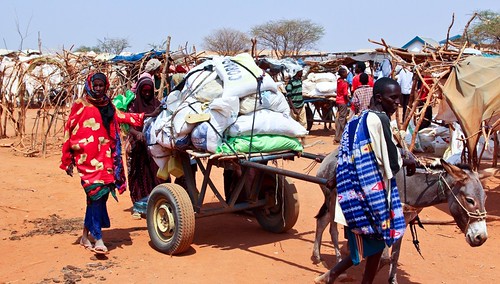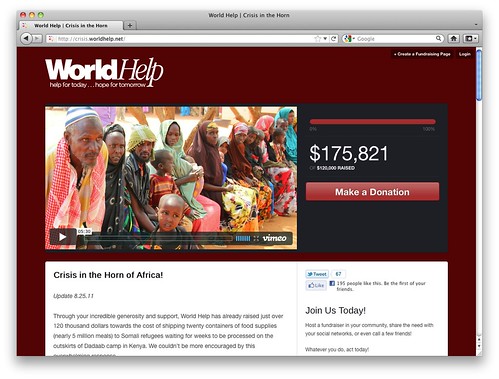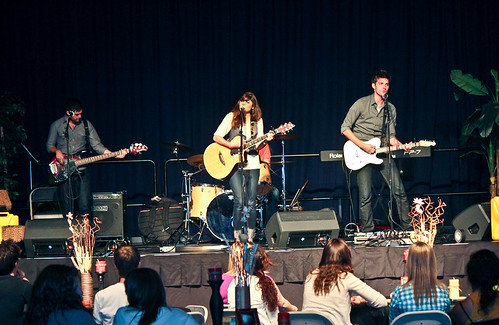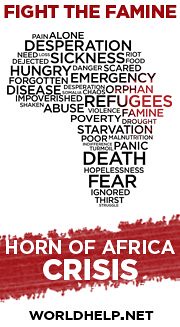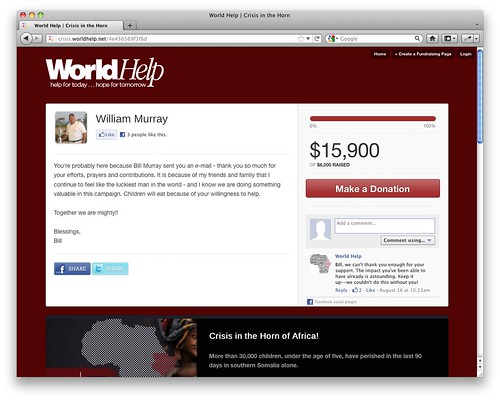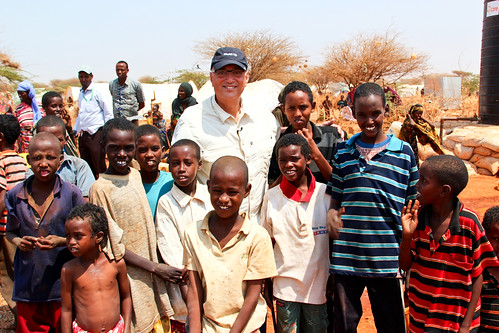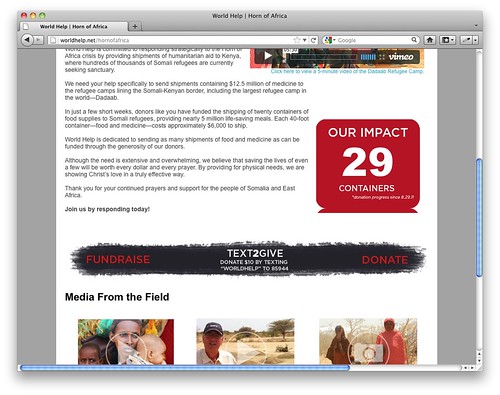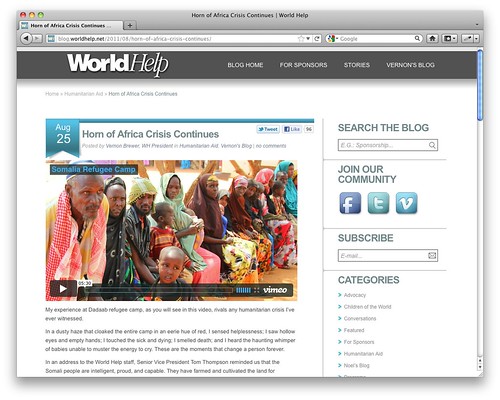“We are so thankful that we found CauseVox! It was the perfect solution for our multi-platform campaigns and we have been able to utilize CauseVox across a variety of projects. Our donors have been thrilled with the features that Causevox offers.” – Noah Barnett, World Help
This case study discusses how World Help raised over $175,000 through their CauseVox fundraising site. In addition, their campaign strategy, techniques, results, and lessons learned from their campaign are all discussed in detail.
About World Help
World Help is a faith-based, humanitarian organization that serves the physical and spiritual needs of people in impoverished communities around the world. It was founded in 1991 by Vernon Brewer, the current president of World Help. World Help’s current staff has over 100 people, mostly residing in their home office in Virginia, but also stationed around the world overseeing different aspects of work.
World Help Campaign
The Crisis in the Horn campaign was organized by World Help. The ultimate goal was to raise $120,000 in order to send 20 containers of food to the Horn of Africa, providing 4.8 million meals to those in desperate need. The campaign had a team of over 150 volunteers help raise awareness and funds for the Crisis in the Horn campaign. Almost 1000 individuals, churches, and businesses made a donation towards the cause.
Campaign Techniques
During the campaign, World Help used several techniques to reach their goal.
Empowering Volunteers – World Help was able to engage with different groups of volunteers to participate on their own levels:
- Reached out to many current supporting churches through donor relations staff and encouraged them to share the need in the Horn of Africa with their congregations, but also show the video that World Help made.
- A staff led initiative was able to connect with a local university’s campus and organized a benefit concert on their campus that had 600 people attend and over $6,000 raised in just one night.
- One of World Help’s church partners in the DC area held a huge benefit concert at their church with recording artist, Meredith Andrews. She also donated half the proceeds of any merchandise sales on the night of the event to the campaign.
- A challenge was pushed out to World Help’s board to come behind this campaign fully – WOW did they respond to the call to action.
Providing Resources – World Help provided supporters additional ways to act in addition to donating by encouraging them to create a fundraising page, sharing the campaign through their social networks, and even wearing a social badge on their social networks to promote the campaign. World Help staff were also sure to keep campaigners and volunteers up-to-date on the latest information and status of the crisis in the Horn of Africa.
CauseVox – CauseVox gave World Help the ability to create an easy to use platform for supporters to engage their own networks with and become part of the bigger voice behind the campaign. This was the first time World Help offered their supporters a platform like this, and they really took hold to it and shared the campaign in their own ways.
Social Media – Social media was an integral force behind World Help’s campaign, and was primarily administered through Facebook, Twitter, Vimeo, and the World Help blog. World Help staff knew that educating people about the famine in Somalia had to be their primary task in order for measurable action to take place.
- World Help reported extensively about the issue on their blog, using a variety of perspectives, angles, and sources, including on-the-ground video clips and photos from their team working in Dadaab, the largest refugee camp in the world. After World Help’s audience was made aware of the desperate situation, they kept the momentum by making the Somalia campaign the focus of most of their online presence.
- World Help used social channels to make announcements regarding their overall progress, to highlight and thank specific supporters, to answer questions, and to direct their community to valuable resources to stay informed on the crisis. These types of communication techniques were used 3-4 times a day for several weeks. Consistency was key.
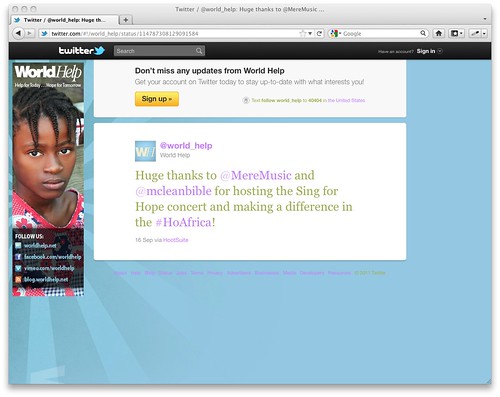
Providing Motivation – Coupled with their email strategy and other physical campaigns (events, donor fundraisers, etc.), World Help maintained a good balance between keeping their audience informed, while involving them in the “we” experience of the campaign. The ultimate goal was to make each participant (or future participant) feel like they were a part of something exciting and positive—that they were joining the campaign in a nationwide effort that was making progress–rather than just contributing out of compulsion or duty.
As with all its social media efforts, World Help sought to build a dedicated group of followers, not just fans. The key is that followers cared enough to get involved.
Telling the story – World Help used a multi-faceted approach in how they shared the story behind the campaign:
- Emails – World Help utilized their newsletter list to send update emails on the crisis in the Horn of Africa, but also used them as an opportunity to inform supporters of ways they could “act.”
- Videos – while World Help staff was on the ground in the Horn of Africa, they were able to put together a collection of short videos that contained mini-stories within the crisis. They also created a longer video that really showed the cause behind the campaign and included a direct call to action. This gave their fundraisers and volunteers an easy tool to share the purpose behind the campaign.
- A web page – World Help created a web page specifically for the campaign to tell the main story behind the campaign, but also act as a hub for update information, photos, and videos.
- Blog posts – throughout the campaign, World Help used their blog platform to tell the stories behind the crisis and then also post from the field reports as their team was in the Horn of Africa.
- One to one – World Help’s donor relations team incorporated the campaign and call-to-actions into their daily conversations with World Help supporters.
- Events – World Help staff were able to personally share the story at a few large scale events. The largest was a crowd of 10,000 live and an unknown number of others via the event’s televised broadcast.
The biggest focus for World Help was being sure that they maintained a sense of urgency in all of their communication during the campaign.
Campaign Results
By the end of the campaign, World Help raised over $175,000 through their customized CauseVox fundraising site.
Every $6,000 raised from the campaign went towards shipping a 40-foot container that held 40,000 pounds of wheat, corn, nutrition-packed soup mix, and much more to supply 240,000 life-saving meals to the current crisis in the Horn of Africa.
Key metrics of the campaign include (rounded figures):
- Fundraising pages that raised $10 or more: 34
- Highest amount raised on fundraising page: $15,900
- Average funds raised per page: $915
- Average online donation size: $190 (including website donations)
- Total number of online donations: 314 (including website donations)
- Facebook “Likes”: 260
Lessons Learned
- Utilize all available channels that are appropriate for the campaign.
- Ensure consistent messaging across all means of communication within the organization (online and off)
- Be sure to engage all demographics of base supporters through different measures
- Do not underestimate the power of students to engage, share, and give towards your campaigns.
- Define a set timeline for future campaigns to emphasize the urgency behind the campaign and target goals.
For more info about World Help, visit their website or follow them on Twitter.
Read more case studies:
